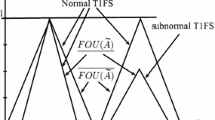Abstract
In this paper, we offered a new method to fit a fuzzy linear regression model to a set of crisp inputs and Gaussian fuzzy outputs, by considering its parameters as Gaussian fuzzy numbers. To calculate the regression coefficients, a nonlinear programming model is formulated based on a new distance between Gaussian fuzzy numbers. The nonlinear programming model is converted to a goal programming model by choosing appropriate deviation variables and then to a linear programming which can be solved simply by simplex method. To show the efficiency of proposed model, some applicative examples are solved and three simulation studies are performed. The computational results are compared with some earlier methods.



Similar content being viewed by others
References
Bates DM, Watts DG (1988) Nonlinear regression analysis and its applications. Wiley, New York
Bazaraa MS, Jarvis JJ, Sherali HD (2005) Linear programming and network flows. Wiley, New York
Celmiņš A (1987) Least squares model fitting to fuzzy vector data. Fuzzy Sets Syst 22(3):245–69
Cernỳ M, Hladík M (2018) Possibilistic linear regression with fuzzy data: tolerance approach with prior information. Fuzzy Sets Syst 340:127–144
Choi SH, Buckley JJ (2008) Fuzzy regression using least absolute deviation estimators. Soft Comput 12(3):257–63
Choi SH, Kim HK, Park KO (2000) Nonlinear regression quantiles estimation. J Korean Stat Soc 29:187–199
Coppi R, D’Urso P, Giordani P, Santoro A (2006) Least squares estimation of a linear regression model with LR fuzzy response. Comput Stat Data Anal 51(1):267–86
Draper NR, Smith H (1998) Applied regression analysis, vol 326. Wiley, New York
D’Urso P, Santoro A (2006) Goodness of fit and variable selection in the fuzzy multiple linear regression. Fuzzy Sets Syst 157(19):2627–47
Hassanpour H, Maleki HR, Yaghoobi MA (2009) A goal programming approach to fuzzy linear regression with non-fuzzy input and fuzzy output data. Asia Pac J Oper Res 26(5):587–604
Hassanpour H, Maleki HR, Yaghoobi MA (2010) Fuzzy linear regression model with crisp coefficients: a goal programming approach. Iran J Fuzzy Syst 7(2):19–39
Hassanpour H, Maleki HR, Yaghoobi MA (2011) A goal programming approach to fuzzy linear regression with fuzzy input-output data. Soft Comput 15:1569–1580
Hojati M, Bector CR, Smimou K (2005) A simple method for computation of fuzzy linear regression. Euro J Oper Res 166(1):172–84
Hong DH, Hwang C, Ahn C (2004) Ridge estimation for regression models with crisp inputs and Gaussian fuzzy output. Fuzzy Sets Syst 142(2):307–19
Hosseinzadeh E, Hassanpour H, Arefi M (2015) A weighted goal programming approach to fuzzy linear regression with crisp inputs and type-2 fuzzy outputs. Soft comput 19(5):1143–51
Hosseinzadeh E, Hassanpour H, Arefi M (2016a) A weighted goal programming approach to estimate the linear regression model in full quasi type-2 fuzzy environment. J Intell Fuzzy Syst 30(3):1319–30
Hosseinzadeh E, Hassanpour H, Arefi M, Aman M (2016b) A weighted goal programming approach to fuzzy linear regression with quasi type-2 fuzzy input-output data. TWMS J Appl Eng Math 6(2):193–212
Hung WL, Yang MS (2006) An omission approach for detecting outliers in fuzzy regression models. Fuzzy Sets Syst 157(23):3109–22
Kao C, Chyu CL (2003) Least-squares estimates in fuzzy regression analysis. Euro J Oper Res 148(2):426–35
Kim B, Bishu RR (1998) Evaluation of fuzzy linear regression models by comparing membership functions. Fuzzy Sets Syst 100:343–352
Koenker R, Bassett G (1978) Regression quantiles. Econometrica 46:33–50
Modarres M, Nasrabadi E, Nasrabadi MM (2005) Fuzzy linear regression models with least square errors. Appl Math Comput 163(2):977–89
Özelkan EC, Duckstein L (2000) Multi-objective fuzzy regression: a general framework. Comput Oper Res 27(7–8):635–52
Peters G (1994) Fuzzy linear regression with fuzzy intervals. Fuzzy Sets Syst 63(1):45–55
Sakawa M, Yano H (1992) Multiobjective fuzzy linear regression analysis for fuzzy input-output data. Fuzzy Sets Syst 47(2):173–81
Savic DA, Pedrycz W (1991) Evaluation of fuzzy linear regression models. Fuzzy Sets Syst 39(1):51–63
Tanaka S, Asai HT, Uegima K (1982) Linear regression analysis with fuzzy model. IEEE Trans Syst Man Cybern 12:903–7
Wunsche A, Naether W (2002) Least-squares fuzzy regression with fuzzy random variables. Fuzzy Sets Syst 130(1):43–50
Wu Q, Law R (2010) Fuzzy support vector regression machine with penalizing Gaussian noises on triangular fuzzy number space. Expert Syst Appl 37(12):7788–95
Xu R (1991) A linear regression model in fuzzy environment. Adv Model Simul 27:31–40
Xu R, Li C (2001) Multidimensional least-squares fitting with a fuzzy model. Fuzzy Sets Syst 119(2):215–23
Yang MS, Lin TS (2002) Fuzzy least-squares linear regression analysis for fuzzy input–output data. Fuzzy Sets Syst 126(3):389–99
Yang Z, Yin Y, Chen Y (2013) Robust fuzzy varying coefficient regression analysis with crisp inputs and Gaussian fuzzy output. J Comput Sci Eng 7(4):263–271
Zadeh LA (1985) Fuzzy sets. Inf Control (Elsevier) 8(3):338–353
Author information
Authors and Affiliations
Corresponding author
Additional information
Communicated by V. Loia.
Publisher's Note
Springer Nature remains neutral with regard to jurisdictional claims in published maps and institutional affiliations.
Rights and permissions
About this article
Cite this article
Hosseinzadeh, E., Hassanpour, H. Estimating the parameters of fuzzy linear regression model with crisp inputs and Gaussian fuzzy outputs: A goal programming approach. Soft Comput 25, 2719–2728 (2021). https://doi.org/10.1007/s00500-020-05331-7
Published:
Issue Date:
DOI: https://doi.org/10.1007/s00500-020-05331-7




